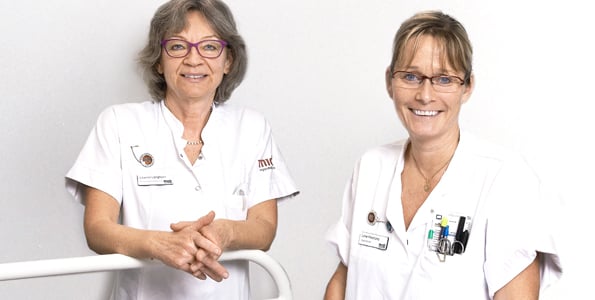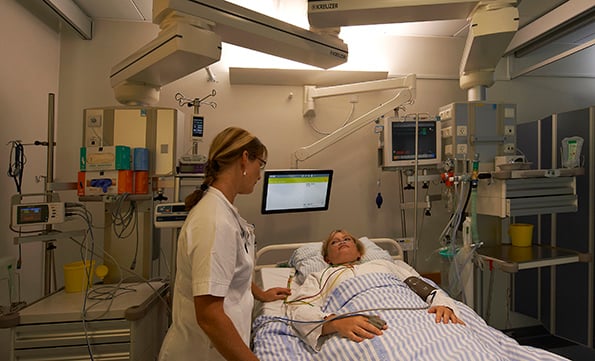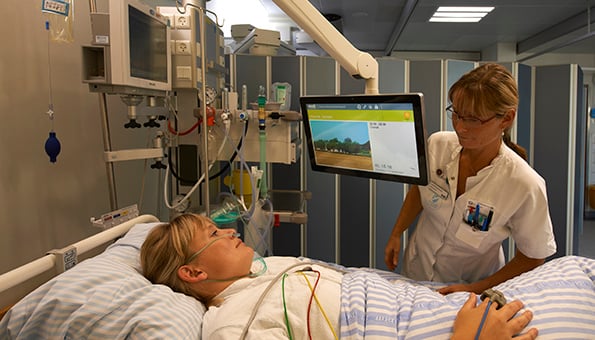Funding has made it possible to establish a groundbreaking research project on developing patient environments in the Neurointensive ward in Aarhus. This innovative solution integrates circadian lighting, functional lighting, noise camouflage, music intervention, individual information screens, and camera surveillance.
The staff is thrilled about the new initiative and is actively engaged in collecting data. "We aim to develop and document new knowledge about the evolving patient environment, and ensure that this knowledge is implemented for the optimization of future patient environments," says the Neurosurgical Department.

Leanne Langhorn and Lone Moeslund, are both associated with the Neurointensive Department NIA. Leanne is a clinical nursing specialist/RN, MScN, PhD and Lone is an intensive care nurse/Coordinator for patient pathways – and they have both been involved from the beginning. In 2010, Leanne completed her PhD project on Post Traumatic Amnesia. As a result, the idea arose to seek research funding for an innovative project on developing a patient environment in collaboration with selected private companies. Through workshops, it was defined that an optimal developing patient environment should minimize anxiety and noise, optimize the patient's private space, provide individual stimuli, create calmness and security for the patient and their family, ensure functional lighting and circadian lighting, and optimize communication.
From innovation project to market development project
The innovation project was carried out in collaboration with MedTech Innovation Center and selected partners from the private sector. Chromaviso provided circadian lighting, SoundFokus provided the sound, Solutors handled the monitoring/control, and VisioSign provided systematic information. In January 2012, the first room at NIA1 was implemented with the new concept. The results from the innovation project were so promising that the experiences were continued in a 2 ½ year market development project, which had two tracks. One track focused on the market development of Chromaviso Circadian Lighting, while the other track focused on the clinical documentation of Chromaviso Circadian Lighting and the integrated patient environment with lighting, sound, visual information, and monitoring. The new funding project started in January 2013 with support from the Market Development Fund. Now, more than a year later, the research is underway – and the staff have gained valuable experiences.
Surrounding the patient
According to Lone Moeslund, they began the innovation project in a single room at NIA1 - and now, the new funding project has expanded to include two sections with four rooms.
— The second section is NIA 2, where Helene Bugge is an intensive care nurse/coordinator for patient care. Both sections have circadian lighting, and two fully equipped rooms with the entire concept. The research results are continuously being collected – we measure various parameters to assess the effects on patients such as blood pressure, respiration, pulse, temperature, behaviour, sleep, etc. We also measure other parameters such as melatonin in the blood and tests of memory and agitation. Naturally, we cannot definitively say anything about the documented effect at this point, but we are seeing signs that patients benefit from the stimulating environment, she explains.

— The project's uniqueness lies in its integrated concept of lighting, sound, visual information, and monitoring, which allows for a comprehensive approach to patient care. The more patients understand their surroundings, the more actively they can participate in early rehabilitation, emphasizes Leanne Langhorn.
Named and ready for the market
The companies from the original innovation project have come together to develop a collaborative product with the evolving patient environment. The concept of integrated lighting, sound, visual information, and monitoring is named CURAVIVO, which translates to "living care". Marketing materials and a website have been created for CURAVIVO. It should be seen as a comprehensive integrated solution that has been developed based on collected user experience. When Leanne, Helene, and Lone explain how CURAVIVO functions in the daily routine of the department, they emphasize that it is the integration of sound, lighting, information, and monitoring that makes the difference. Additionally, CURAVIVO is advantageous for patients, staff, and relatives. To describe CURAVIVO in as much detail as possible, the benefits of lighting, sound, info screen, and monitoring are discussed separately.
Natural circadian rhythm and enhanced sleep
CURAVIVO's lighting component fulfils the desire for focused light, functional night light, and accessible daylight. Chromaviso's Circadian Lighting contributes to a natural circadian rhythm for both patients and staff. The functional night light allows the staff to disturb the patient as little as possible when performing their work at night.
Chromaviso Circadian Lighting follows the natural rhythm of the sun, gradually increasing in intensity and brightness in the morning to gently wake the patient. Throughout the day, the light continues to increase in strength. In the afternoon, the light becomes warmer in colour, creating a calming and soothing atmosphere as the evening approaches. This intelligent lighting system is installed in ceiling fixtures, wall lights, spotlights, and even in the writing desk drawer, creating a comprehensive lighting experience.
During the night, the natural daylight is turned off, and a soft amber night light with built-in monitoring is used instead. This allows for minimal disturbance during nighttime monitoring of the patient. When recording vital signs such as temperature, blood pressure, respiration, and pulse, a built-in light in the writing desk is utilized. The immediate effects of Chromaviso Circadian Lighting on both patients and staff are noticeable, positively influencing the patient's sleep pattern. A well-rested patient is less confused and more prepared for early rehabilitation.
Noise reduction and music stimulation
In the intensive care units, patients are often exposed to disruptive noise from the surroundings, machines, other patients, and staff. The aim of CURAVIVO's sound component is to regulate the noise levels and manage noise during acute situations using directional sound. Additionally, music intervention can be used to stimulate the patients.
During acute situations, it is possible to camouflage the noise, minimizing the impact on other patients and their relatives. This is achieved through the use of a screeching camouflage noise that masks speech and other sounds. When the emergency lighting is activated, the camouflage noise and camera surveillance on the other beds are automatically triggered. This proves to be highly effective when the staff needs to focus on a patient with urgent needs.

CURAVIVO also offers "music intervention" which involves using music to stimulate the patient. Niels Eje's MusiCure is used for relaxation, stress relief, and calming the patient, although only for half an hour at a time. Music intervention also has a positive effect on both staff and relatives. The conscious work of regulating noise and using music intervention has a calming effect on the patients. The extent to which patients in the Neurointensive unit are affected by noise camouflage and music stimulation is still unknown. This area is currently the subject of significant research interest.
Personalized systematic information
The information component of CURAVIVO opens up new possibilities for patients, relatives, and staff.
Each bed has an info board installed on a flexible arm. The screen displays the patient's identity, location, and current time, allowing for quick and systematic orientation. It also shows the daily program and a general plan for the patient. Patients in the Neurointensive unit often wake up disoriented, not knowing where they are. They may think they are in a supermarket or on a go-kart track. As patient conditions vary greatly, providing individual systematic information is advantageous.
The visual component can be used to stimulate the patient, for example, with mood photos and seasonal images. An elderly lady on a respirator showed no reaction to anything, but when she saw a photo on the screen with beautiful colourful tulips, she displayed a clear reaction.
The touchscreen info board can be used for assistive programs and rehabilitation, acting as a pointing device for those who cannot speak. It is also possible to display selected TV programs or access the internet, like Google Earth. The use of the info board can be expanded as needed. The staff can utilize it as a tool to inform, train, entertain, and facilitate conversation with the patient.
Surveillance as part of an integrated environment
Surveillance is a crucial part of the CURAVIVO concept, and it often evokes a strong response from the patients' relatives. From the beginning, the staff makes it clear to the relatives that the surveillance cameras are not constantly on and that the department does not store any information. However, understanding how surveillance works provides the greatest sense of security for both the patients and their loved ones.
The surveillance is primarily used at night, allowing the staff to observe the patients without disturbing their sleep, which is a significant advantage. In acute situations, when emergency lighting is activated, the surveillance and camouflage noise automatically come into play. The CURAVIVO concept is an integrated environment that also benefits the staff. Consequently, employee well-being is a part of the research project. For a period of time, the staff wears an "Acti Watch" that measures rest, activity, and exposure to light.
Research in collaboration with multiple hospitals
The market development project, which has a total budget of 9.6 million kr, is a collaboration between Chromaviso, Glostrup Hospital, and Aarhus University Hospital.
The research aspect of the project takes place at the Neurosurgical Department at Aarhus University Hospital and the Neurological Department at Glostrup Hospital. Both locations focus on researching the perspectives of both patients and staff.
At the Neurological Department at Glostrup Hospital, the research is dedicated to Chromaviso Circadian Lighting, focusing on different patient groups. Meanwhile, at the Neurosurgical Department at Aarhus University Hospital, research is also conducted on the evolving patient environment, including lighting, sound, visual information, and monitoring. The project involving the evolving patient environment includes collaboration with partners such as Hammel Neurocenter, Neurointensive at Rigshospitalet, and the Department for Highly Specialized Neurorehabilitation/Traumatic Brain Injury at Glostrup Hospital.
Neurointensive Unit (NIA) at Aarhus University Hospital
The Neurointensive Unit, also known as NIA, is an integral part of the Neurosurgical Department at Aarhus University Hospital. This department serves as a national and regional centre for the diagnosis, treatment, and care of patients with congenital and acquired conditions affecting the skull, brain, cerebral vessels, membranes, nerves, and spine. Neurosurgical Department NK comprises two ward units, an outpatient clinic, an intensive care unit (NIA), a recovery unit (NIA), and an operating unit (NOA).
The Neurointensive Unit, also known as NIA, provides care and treatment for patients with cranial injuries, brain haemorrhages, brain tumours, and central nervous system malformations. NIA is led by two department nurses, each with their own team of approximately 45 nurses. The Neurointensive Unit is divided into two care units - NIA 1 and NIA 2 - with a total capacity of 12 patients who require intensive observation, treatment, and care. Each unit consists of two patient rooms and an observation room/office.

